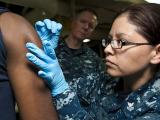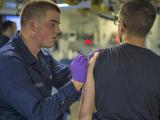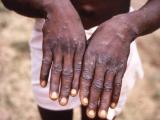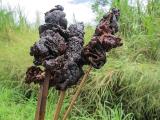Jul 17, 2003 (CIDRAP News) Researchers at Vanderbilt University will study three different types of bandages for smallpox shot sites to compare their ability to prevent spread of the vaccinia virus and their effects on healing time, the university announced.
In the randomized study, participants will receive either gauze and tape, a "single-occlusive" bandage with gauze, or a waterproof "hydro polymer" bandage, Dr. Tom Talbot, an instructor in infectious diseases, said in a report in Vanderbilt University Medical Center's (VUMC's) newsletter, The Reporter.
Occlusive (sealing) bandages lower the risk of spreading the vaccinia virus from the vaccination site to others, but they may slow healing of the lesion by keeping it moist, Talbot noted. Occlusive bandages also cost more, he said, adding, "Our study will answer the question of whether this type of dressing is worth the cost."
VUMC is one of many hospitals that have decided not to vaccinate their staffs against smallpox for now because of concern that workers could spread the virus to at-risk patients, the article said. People with eczema or a weakened immune system may be at risk for severe complications if they contract vaccinia.
Researchers will recruit for the trial both young adults who never had a smallpox shot and slightly older adults who previously had a shot, the report said.
VUMC previously conducted two studies to assess the effectiveness of the government's decades-old smallpox vaccine at different dilutions, the report said. The second trial included an assessment of how well a double-occlusive bandage contained the virus. Researchers cultured an area on the outside of the bandage in 917 participants and found virus in only 6 cases, according to Talbot. In addition, culturing of samples from the index finger on the hand opposite the vaccination site showed the virus was present in only 2 of 925 cases.
"From the previous study we know the double-occlusive bandages are extremely effective," Talbot said. "What we'll be able to tell now is how all these dressings compare. The big question is how effective the gauze bandage will be at containing the virus, and what effect on healing time the various dressings may have."
The Centers for Disease Control and Prevention (CDC) currently advises healthcare workers to cover their smallpox vaccination site with gauze and a semipermeable or semiocclusive dressing, meaning one that allows air to pass through but blocks fluids.
The CDC reported last week that 14 cases of vaccinia transmission from vaccinees to contacts have occurred in the US military vaccination program, but no cases had occurred in the civilian program through Jun 20.
See also:
Vanderbilt newsletter report on the bandage study
http://www.mc.vanderbilt.edu/reporter/index.html?ID=2766
CDC recommendations on caring for smallpox vaccination sites
http://www.bt.cdc.gov/agent/smallpox/vaccination/site-care-vis.asp





















